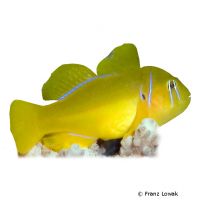Poison Goby (Gobiodon citrinus)
| Poison Goby Gobiodon citrinus | |
|---|---|
| Name | Poison Goby |
| Name Lat. | Gobiodon citrinus |
| Synonym | Gobius citrinus |
| Family | Gobies |
| Family lat. | Gobiidae |
| Order | Gobies |
| Order lat. | Gobiiformes |
| Origin | Indo-West Pacific |
| Habitat | Coral reefs |
| Diet | Planktivore |
| pH | 8.1-8.4 |
| Hardness | 8-10 °KH |
| Behavior | Peaceful |
| Keeping | Pair with stony corals |
| Reef Compatible | Yes |
| Care Level | Easy |
| Life Span | 5-8 years |
| Protection | No |
| Metric Units | |
| Size | 6 cm |
| Temperature | 22-28 °C |
| Salinity | 33-36 ‰ |
| Aquarium | ~ 200 l |
| US Units | |
| Size | 2.4" |
| Temperature | 72-82 °F |
| Salinity | 1.020-1.025 sg |
| Aquarium | ~ 50 gal |
Distribution and habitat
Gobiodon citrinus are distributed from the Red Sea and tropical Indian Ocean to the Great Barrier Reef and Samoa in the Western Pacific. They live in the coral reefs of lagoons and reef slopes protected from strong surf, where they usually stay in pairs or in larger colonies in the branches of stony corals.
Maintenance
The aquarium should have a reef structure with living stones that act as a biological filter and stony corals (Acropora spp.) that serve as hiding places, resting places and retreats. Only calcareous, heavy metal-free sands, gravels, stones or sea sand of various grain sizes may be used as substrate.
To ensure water quality, filters, skimmers and heaters are necessary, as well as pumps to simulate tides, swells and bottom currents. Lighting must correspond to the species-appropriate day-night rhythm of the animals
| Salinity: 33-36 ‰ | pH value: 8.1-8.4 |
| Carbonate hardness: 8-10 °KH | Nitrate content: 2-8 mg/l |
| phosphate content: 0.01-0.1 mg/l | nitrite content: 0.0-0.05 mg/l |
For salinity, an average value should be aimed for, which may only vary slightly by +/- 0.5 ‰. Ammonia and ammonium must not be measurable. Special attention must be paid to constantly good water quality.
Diet
In nature they feed mainly on zooplankton. The feed change usually succeeds without problems. The food supply should consist of a combination of live and frozen food, such as small mysis, artemia, bosmids and cyclops, with chopped shrimp and crab meat or a commercially available, vitamin-enriched, frozen food mix for planktivores. High-quality flake and granulated food is also often accepted after an acclimation period
It is recommended to feed small portions several times a day. Regular and varied feeding promotes health and increases resistance.
Behaviour and compatibility
They live in the branches of stony corals (Acropora spp.) and can be kept singly or in pairs if the stony coral population is sufficient. To avoid territorial disputes, they should be introduced into the aquarium at the same time. Socialization with other peaceful fish is well possible.
Sex dimorphism
They are probably simultaneous hermaphrodites (simultaneous hermaphrodites) whose role distribution is determined by the respective dominance status. The larger, dominant animal always has male status
Reproduction and breeding
They form monogamous breeding pairs. Before laying eggs, the female removes the polyp tissue from the coral on a small area. Then she lays the eggs on the bare coral skeleton and the male guards the clutch. The tissue of the coral grows back under good conditions
Important
They wait on the branch ends of their living corals for passing plankton and retreat between the coral branches in case of danger. Weak corals cannot permanently survive the harassment as well as the damage during nest building
If different species are kept together, care must be taken to ensure that the fish match each other in terms of water quality and temperature requirements, as well as their social behavior, and that the setup meets the needs of all species kept together. Newly introduced fish must be acclimated slowly to the water in the aquarium
Further literature can be found in your pet store.
References
Text: Lucie Schiemer; Image: Franz Lowak
Source: BAENSCH & DEBELIUS (1997): Meerwasseratlas, Bd. 1, Mergus Verlag ENGELMANN (2005): Zootierhaltung - Tiere in menschlicher Obhut: Fische, Verlag Harri Deutsch
- Gemäß § 21 Abs. 5 Tierschutzgesetz idgF
